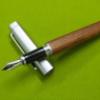Search the Community
Showing results for tags 'vermillion'.
-

A Review Of Namiki Yukari Royale In Vermillion(Red) Urushi
sannidh posted a topic in Fountain Pen Reviews
A wait longer than words can define, an Emperor in Red singing a glistening rhapsody, and then a Yukari dazzling in Royale Red glory. The pens, an encompassment of elegance of words, combined with precision of maki-e artisans have been unsurpassed. The Yukari did anxiously waited in my hands to have... -
Dazzled by the resplendent allure of a Japanese ED (with the concept of a shut-off valve mechanism), the lust for an urushi lacquered pen vis-a-vis plain ebonite ones (seemingly susceptible to lose shine and colour over time) did keep growing on me for some time, before I took this plunge! I have co...
- 152 replies
-
Hello fellow pen enthusiasts, So far I have seen just one review on the internet for this pen and I strongly felt it merited another look. The comments about it being a baseball bat are, though funny and mostly in good humor, about as appropriate as saying Babe Ruth's bat was but a twig to be burn...
-
Hi everyone, I've been waiting a little impatiently for this pen to arrive I've started to get interested in japanese urushi pens recently and wanted to stretch out my collection that is mostly made out of european celluloid pens (ie. omas,montegrappa,pelikan etc.) My first urushi pen was a mikad...
- 54 replies
-
- custom urushi
- pilot
-
(and 3 more)
Tagged with:
-
Guider pen works is by now possibly well known on FPN with reviews dating back to 2008. They started in 1946 at Rajahmundry in Andhra Pradesh, India. Since they started under the guidance of their mentor from the famous pen making firm Ratnam and brothers, the firm was named Guider. http://guiderpe...
-
Looking To Buy A Namiki Emperor Red Vermillion Urushi Fountainpen, Anyone Help?
dior523 posted a topic in Japan - Asia
Hi everyone, I am looking to buy a Namiki Emperor Red Vermillion Urushi Fountain pen, Anyone help? Please recommand any on line shop and personal seller is fine. Thank you for your help!































